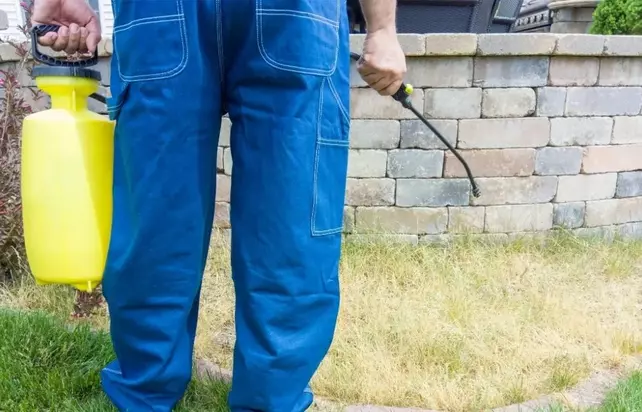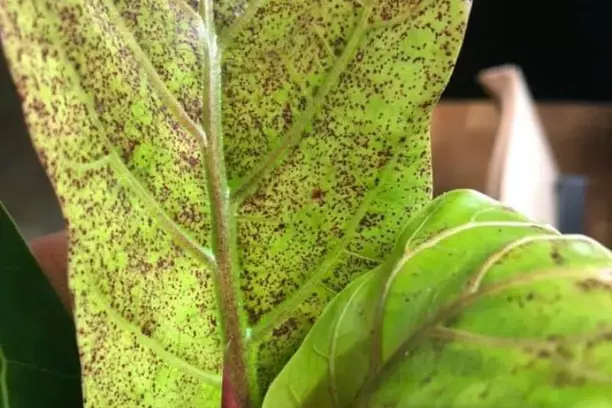This weed, also known as ground ivy, can be a nuisance because of its fast-spreading nature and ability to choke out other plants. But fear not, we have some tips on how to get rid of creeping Charlie and keep your lawn looking healthy.
First, it’s important to identify creeping Charlie in your lawn or garden. It has round, scalloped leaves that are green or purple, and small purple flowers in the spring. Once you’ve identified it, there are a few methods to get rid of it. One way is to manually pull it out, making sure to get the roots as well. Another method is to use herbicides specifically designed to target creeping Charlie. However, it’s important to follow the instructions carefully and not use too much, as it can harm other plants in your lawn or garden.
Identifying Creeping Charlie
Physical Characteristics
Creeping Charlie, also known as ground ivy, is a member of the mint family. Its leaves are round or kidney-shaped with scalloped edges and grow on long petioles. The leaves have a distinct odor when crushed, which is similar to mint. The stem of the plant is square, and it can grow up to 12 inches in length. Creeping Charlie produces small, purple flowers in the spring that bloom in clusters.
Habitat and Growth Pattern
Creeping Charlie prefers moist, shaded areas and can thrive in both sun and shade. It is an evergreen perennial that spreads by runners, making it difficult to control. It can grow in lawns, gardens, and natural areas, and it is often considered a weed. Creeping Charlie can quickly take over an area if left unchecked.
To identify Creeping Charlie, look for the plant’s distinct physical characteristics. It is important to identify the plant correctly before attempting to control it, as many other plants have similar leaves and growth patterns.
In conclusion, identifying Creeping Charlie is crucial in controlling its spread. By understanding its physical characteristics and growth patterns, we can effectively manage this invasive plant.
Understanding the Problem
Why It’s an Issue
As homeowners, we understand the importance of maintaining a healthy and attractive lawn. However, one of the most common issues we face is dealing with invasive weeds like Creeping Charlie. Creeping Charlie, also known as ground ivy, is a perennial broadleaf weed that can quickly take over our lawns, choking out the turf and other desirable plants.
Creeping Charlie is a particularly troublesome weed because it has a shallow root system that allows it to spread quickly and easily. Additionally, it can regrow from even small fragments of its stems and nodes, making it difficult to eradicate completely.
How It Spreads
Creeping Charlie is native to Europe but has become an invasive weed in North America. It thrives in moist, shady areas and is often found in lawns and other turf areas. It spreads through both seeds and stem fragments, which can be carried by wind, water, and even lawn mowers.
Once established, Creeping Charlie can quickly take over a lawn, forming a dense mat that can smother other plants. It is particularly problematic in the fall when it begins to flower and produce seeds, which can then spread the weed even further.
To effectively control Creeping Charlie, it’s important to first understand the nature of the problem. By recognizing the weed’s characteristics and how it spreads, we can take steps to prevent its growth and ultimately eliminate it from our lawns.
Manual Removal Techniques
If you’re looking for a more hands-on approach to getting rid of creeping Charlie, manual removal techniques can be a great option. There are a few different methods you can use, including hand-pulling and using tools.
Hand-Pulling
Hand-pulling is a simple and effective way to remove creeping Charlie from your lawn or garden. To do this, you’ll need a good pair of gardening gloves to protect your hands from the plant’s sticky leaves. We recommend using gloves made from a durable material like leather or synthetic leather, as they will provide the most protection.
Once you have your gloves on, you can start hand-pulling the creeping Charlie. This involves grabbing the plant at the base and pulling it up from the ground. Be sure to pull slowly and steadily to ensure you get the entire root system.
Using Tools
If you have a larger infestation of creeping Charlie, or if you just prefer using tools to hand-pulling, there are a few different options you can try. One popular tool for removing creeping Charlie is a pitchfork. This can be used to loosen the soil around the plant, making it easier to pull up.
Another tool you can use is a trowel. This can be especially helpful if you’re dealing with creeping Charlie in a garden bed or other tight space. Use the trowel to dig around the base of the plant, then gently lift it out of the ground.
Finally, a cultivator can be a great tool for removing creeping Charlie from larger areas. This tool is designed to loosen and aerate the soil, which can make it easier to pull up the plant. Simply run the cultivator over the affected area, then use your hands or a pitchfork to remove the creeping Charlie.
Overall, manual removal techniques can be a great way to get rid of creeping Charlie. Whether you prefer hand-pulling or using tools, there are plenty of options available to help you get the job done.
Using Covering Methods
When dealing with a creeping Charlie infestation, covering the affected area can be an effective method to control its growth. There are several covering methods that can be used, including smothering, using tarps, or plastic.
Smothering
Smothering involves covering the creeping Charlie with organic materials like cardboard, newspaper, or mulch. This method deprives the plant of sunlight and air, which it needs to survive. To use this method, follow these steps:
- Cut the creeping Charlie as close to the ground as possible.
- Cover the area with a layer of cardboard or newspaper, making sure to overlap the edges to prevent any sunlight from getting through.
- Cover the cardboard or newspaper with a layer of mulch or other organic material.
This method can take several weeks to be effective, so be patient and monitor the area regularly.
Using Tarps or Plastic
Using tarps or plastic is another effective method to control the growth of creeping Charlie. This method works by blocking sunlight and air from reaching the plant. To use this method, follow these steps:
- Cut the creeping Charlie as close to the ground as possible.
- Cover the area with a tarp or black plastic, making sure to weigh down the edges with rocks or bricks to prevent any sunlight from getting through.
- Leave the tarp or plastic in place for several weeks, monitoring the area regularly.
This method can be more effective than smothering, but it can also be more time-consuming and require more effort.
In conclusion, covering methods can be an effective way to control the growth of creeping Charlie. Whether you choose to smother the plant with organic materials or use tarps or plastic to block sunlight and air, be patient and monitor the area regularly for best results.
Chemical Control
When it comes to getting rid of creeping Charlie, chemical control is one of the most effective methods. However, it’s important to choose the right herbicide and apply it safely to avoid any damage to your lawn or the environment. In this section, we’ll discuss some important considerations when using herbicides for controlling creeping Charlie.
Choosing the Right Herbicide
There are a few different herbicides that can be effective at controlling creeping Charlie. Here are some of the most common options:
- Broadleaf herbicides: These herbicides are designed to kill broadleaf weeds like creeping Charlie, while leaving grass unharmed. Look for a broadleaf herbicide that contains 2,4-D, dicamba, or triclopyr as the active ingredient.
- Borax: Borax is a natural mineral that can be used to kill creeping Charlie. Mix 10 ounces of borax with 4 ounces of water and apply to the affected area.
- Homemade weed killer: You can also make your own weed killer by mixing vinegar, salt, and dish soap. However, be careful when using this method, as it can also kill grass and other plants.
Before choosing a herbicide, consider the size of the affected area, the type of grass you have, and any environmental concerns. Always read the label carefully and follow the instructions for use.
Applying Herbicides Safely
When applying herbicides to control creeping Charlie, it’s important to take safety precautions to avoid any harm to yourself, others, or the environment. Here are some tips for applying herbicides safely:
- Wear protective clothing, including gloves, long sleeves, and pants.
- Use a pump sprayer to apply the herbicide evenly and avoid overspray.
- Avoid applying herbicides on windy days or when rain is expected.
- Keep children and pets away from the treated area until the herbicide has dried.
- Follow all instructions on the label carefully.
By choosing the right herbicide and applying it safely, you can effectively control creeping Charlie and maintain a healthy lawn.
Lawn Care to Prevent Regrowth
Watering and Mowing
To prevent regrowth of creeping Charlie in your lawn, it is important to maintain proper watering and mowing habits. We recommend watering your lawn deeply and infrequently, rather than shallowly and frequently. This will encourage deep root growth and make your lawn less susceptible to drought and weed growth. Additionally, it is important to mow your lawn regularly, and to keep your mower blade sharp. A dull blade can tear the grass, leaving it susceptible to disease and weed growth.
Fertilizing and Overseeding
Fertilizing and overseeding your lawn can also help prevent regrowth of creeping Charlie. We recommend fertilizing your lawn in the fall, when grass is actively growing, with a slow-release fertilizer. This will help your grass grow strong and healthy, making it less susceptible to weed growth. Additionally, overseeding your lawn in the fall can help fill in any bare spots and make it more difficult for weeds to grow.
When overseeding, it is important to choose a grass seed that is appropriate for your climate and soil type. We recommend using a mix of grass seed varieties that are resistant to disease and pests, and that are well-suited to your lawn’s growing conditions.
Weed Control
In addition to proper lawn care practices, it may be necessary to use weed control products to prevent regrowth of creeping Charlie. However, it is important to use these products responsibly, and to follow all label instructions carefully. We recommend using a selective herbicide that targets broadleaf weeds, such as creeping Charlie, while leaving your grass unharmed. It is important to apply these products according to the label instructions, and to avoid using them on windy days or when rain is expected.
Overall, by following these lawn care practices, you can help prevent regrowth of creeping Charlie in your lawn, and maintain a healthy, lush lawn.
Alternative Ground Covers
Choosing the Right Plants
When it comes to alternative ground covers, there are several options to choose from. It’s important to choose the right plants that will thrive in your specific environment. Some popular options include:
- Lysimachia nummularia (also known as Creeping Jenny): This is a mat-like ground cover that does well in moist areas and is great for preventing soil erosion.
- Vinca minor (also known as Periwinkle): This is a low-growing vine that does well in shady areas and is great for landscaping.
- Pachysandra terminalis (also known as Japanese Spurge): This is an ornamental plant that does well in shady areas and is great for flower beds.
When choosing the right plants, it’s important to consider factors such as soil type, amount of sunlight, and water availability. It’s also important to consider the specific needs of the plant, such as pruning and fertilization requirements.
Planting and Maintenance
Once you’ve chosen the right plants, it’s important to properly plant and maintain them. Here are some tips:
- Prepare the soil: Before planting, prepare the soil by removing any weeds or debris. Add compost or fertilizer if necessary.
- Plant the ground cover: Plant the ground cover according to the instructions on the label. Make sure to space the plants properly to allow for growth.
- Water regularly: Water the ground cover regularly, especially during dry spells. Use a garden hose or watering can to avoid overwatering.
- Mulch: Apply a layer of mulch around the ground cover to help retain moisture and suppress weeds.
- Prune: Prune the ground cover as needed to prevent overgrowth and maintain its shape.
- Prevent weed growth: To prevent weed growth, apply a pre-emergent herbicide in the spring and fall. Hand-pull any weeds that do appear.
By choosing the right plants and properly maintaining them, you can successfully replace creeping Charlie with a beautiful and functional alternative ground cover.
Disposal of Creeping Charlie
Bagging and Removal
When it comes to disposing of creeping Charlie, it is essential to take the necessary precautions to prevent it from spreading further. We recommend wearing gloves and using gardening shears to cut the plant as close to the ground as possible. Be sure to bag the clippings immediately and seal the bag tightly to prevent any escape of the plant material.
It is also important to note that creeping Charlie spreads through rhizomes, which are underground stems that can sprout new plants. To prevent the spread of rhizomes, we recommend digging out as much of the plant as possible, making sure to remove all roots and runners.
If you have a large area infested with creeping Charlie, you may need to rent a lawn waste bag or hire a professional to remove the plant material. Be sure to let them know that the waste is contaminated with creeping Charlie to avoid spreading it to other areas.
Composting Considerations
While composting is an excellent way to recycle garden waste, it is not recommended for creeping Charlie. The plant can survive in compost piles and spread to other areas when the compost is used. If you must compost the plant, we recommend using a hot composting method that reaches a temperature of at least 140 degrees Fahrenheit for several days to kill any remaining rhizomes.
To prevent the spread of creeping Charlie, we recommend disposing of the plant material in the trash. You can also place the clippings on a sheet of newspaper and let them dry out in the sun for a few days before disposal.
In summary, eradicating creeping Charlie requires proper disposal methods. We recommend bagging and removing the plant material immediately, digging out as much of the plant as possible, and avoiding composting. With these precautions, we can prevent the spread of creeping Charlie and keep our gardens healthy.
Frequently Asked Questions
What are some effective herbicides for eliminating Creeping Charlie?
There are several herbicides that are effective at eliminating Creeping Charlie, including 2,4-D, dicamba, and triclopyr. These herbicides are often found in combination products that are specifically formulated to target Creeping Charlie. Be sure to read the label carefully and follow all instructions for application.
How can I prevent Creeping Charlie from spreading on my lawn?
Preventing Creeping Charlie from spreading in your lawn can be challenging, but there are a few things you can do to help. First, make sure your lawn is healthy and well-maintained. A thick, healthy lawn is less likely to be invaded by weeds like Creeping Charlie. Second, avoid over-watering your lawn, as this can create conditions that are favorable to the growth of weeds. Finally, consider using a pre-emergent herbicide in the spring to prevent Creeping Charlie from germinating.
Are there any natural methods for getting rid of Creeping Charlie?
Yes, there are several natural methods for getting rid of Creeping Charlie. One effective method is to manually remove the weed by hand, being sure to remove as much of the root system as possible. Another method is to smother the weed by covering it with a layer of mulch or black plastic. Finally, you can try using a natural herbicide like vinegar or boiling water to kill the weed.
What are the best times of year to treat Creeping Charlie?
The best times of year to treat Creeping Charlie are in the spring and fall, when the plant is actively growing. During these times, the weed is more susceptible to herbicides and other treatments. Be sure to read the label carefully and follow all instructions for application.
Can I use vinegar to kill Creeping Charlie?
Yes, vinegar can be an effective natural herbicide for killing Creeping Charlie. However, it is important to note that vinegar can also damage or kill desirable plants, so use it with caution. To use vinegar as a herbicide, mix it with water in a 1:1 ratio and spray it directly on the weed.
Which commercial products are most effective at killing Creeping Charlie?
There are several commercial products that are effective at killing Creeping Charlie, including Ortho Weed B Gon, Bayer Advanced Lawn Weed and Crabgrass Killer, and Spectracide Weed Stop for Lawns. Be sure to read the label carefully and follow all instructions for application.



